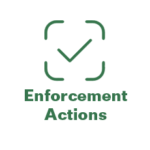- Home
- Public
- Resources
- Advanced Search
- Advisory Boards
- Careers
- District Offices
- e-Payment
- Enforcement Actions
- Meet the Director
- Mission Statement and Values
- Nondiscrimination Policy
- Outreach and Public Information
- Public Comments Online Portal
- Public Notices
- Records Requests
- Spill and Complaints
- State of the Environment
- Topics
- Divisions
- News
- Calendar
Active Sites
- Home
- Solid & Hazardous Waste
- Orphan Sites
- Active Sites
The DEQ undertakes enforcement actions to preserve safe environmental conditions throughout Wyoming.
This page contains information on the enforcement actions that the Solid and Hazardous Waste Division may undertake, as well as a record of enforcement actions that have been undertaken by SHWD.
If the download box is not working below, please click here.
In response to the Governor's request to limit contact and the move toward most WDEQ staff working remotely for the near future, the Solid and Hazardous Waste Division (SHWD) have made electronic document submittal available. This includes work plans, reports, general correspondence and Solid Waste permit applications. Electronic submittal forms are now available for SHWD programs. Please choose the appropriate form from the list of links below to upload documents. If submitted electronically, no hardcopy is required to be submitted unless you are contacted by SHWD staff with a request to submit the hard copy. Please note that SHWD is unable to accept comments on documents in public notice via these forms. Please refer to the public notice for instructions on how to submit comments.
Hazardous Waste, Voluntary Remediation, Orphan Site Programs
https://bit.ly/WDEQ-SHWD-HW-
https://bit.ly/WDEQ-SHWD-STP-upload
This page contains any proposed Rules or Regulations that are currently under development within the Solid and Hazardous Waste Division.
Hazardous Waste Rules, Chapter 1
The Hazardous Waste Rules, Chapter 1, General Provisions were adopted and filed with the Wyoming Secretary of State on April 7, 2022. See https://rules.wyo.gov/.
Solid Waste
The Solid Waste Permitting and Corrective Action Program is conducting a public outreach on proposed revisions to the Solid Waste Rules Chapter 3 Industrial Landfills Regulations.
All official Wyoming State Rules and Regulations are kept at the Wyoming Secretary of State’s Office. Click here to view all current Rules and Regulations.
Active Orphan Sites
This page provides information on Orphan sites that are currently active in the remediation process. These sites and specific information are listed on the right.
Visit the Orphan Site StoryMap for an interactive look at our current sites.
The Casper Perchloroethylene (PCE) Plume Orphan Site is approximately 150 acres in an area that is bound to the north by the North Platte River, the south by East 5th Street, the west by Center Street, and the east by Bryan Stock Trail. The area is comprised of residential, commercial and industrial neighborhoods. Environmental testing in the late 1980s revealed the presence of PCE in groundwater in downtown and north Casper, as well as in the indoor air of some homes.
The Wyoming Department of Environmental Quality (DEQ) has designated the Casper PCE Plume Orphan Site as a high priority orphan site. The designation is due to the number of people in proximity to the plume, the discharge of the plume into the North Platte River, and the carcinogenic nature of PCE. When funding has been available the DEQ has continued to investigate, monitor, and remediate the plume.
Currently, the DEQ is monitoring the effectiveness of the remedies implemented to remediate the PCE plume. If you have any questions about the project, please contact the Project Manager, Matt Buchholz at 307-777-8937 or at matt.buchholz@wyo.gov.
Recent Public Meetings:
- March 28, 2017: The DEQ held a public meeting to inform concerned parties about the plan to remediate the PCE plume.
Site Investigation Milestones:
- November – December 2009: The DEQ installed groundwater monitoring wells and soil vapor sampling points throughout the study area.
- March 2010 – March 2011: The DEQ tested indoor air and subslab soil gas at potentially affected properties.
- June 2010 – August 2011: The DEQ installed indoor air mitigation systems at residential and commercial buildings.
- August 2011: Installation of additional groundwater wells along the northern portion of the plume.
- Spring 2014: The DEQ used High Resolution Site Characterization (HRSC) techniques to investigate a source area to acquire information that would allow a Remedial Alternatives Evaluation to be completed. During this work the DEQ was able to show another PCE plume (further upgradient) was contributing to the Casper PCE plume.
- Spring 2015: The DEQ approved the Source Characterization Report (1/9/15), allowing the DEQ to evaluate remedial alternatives.
- May 2016: The DEQ approved the Remedial Alternatives Evaluation Report (RAER) (5/9/16), which included a recommendation to do additional HRSC at the furthest upgradient source. The RAER suggested implementing Soil Vapor Extraction (SVE) in conjunction with Enhanced In-Situ Bioremediation (EISB) for the source of the plume, and Monitored Natural Attenuation (MNA) for the rest of the plume.
- July 2016: The DEQ completed the HRSC investigation (7/11/16) at the furthest upgradient source.
- November 2016: The DEQ approved the SVE work plan (11/1/16).
- May 2017: The DEQ approved the EISB work plan (5/3/17).
- July 2017: The DEQ received the SVE installation report (7/10/17).
- July 2017: The DEQ approved the MNA work plan (7/13/17).
- October 2017: The DEQ received the EISB remedy completion report (11/17/17).
If the download box is not working below, please click here.
The Cheyenne Perchloroethylene (PCE) Plume orphan site is an area approximately 20 acres in size within a roughly 5 block by 3 block area of downtown Cheyenne, Wyoming. The site is centered 1 block directly west of the Herschler Building, 122 West 25th Street, Cheyenne and consists of a mixture of single and multi-home residential properties, government buildings, and commercial businesses. The chlorinated solvent contamination was first discovered in soil and shallow groundwater (5 to 15 feet below ground surface) following a Limited Subsurface Investigation conducted in December 2002 by ERM on behalf of the former Safeway Store located at 2512 Pioneer Ave, Cheyenne.
Wyoming Department of Environmental Quality (DEQ) Project Manager:
Carol Stark, Project Manager, 307-777-8759, carol.stark@wyo.gov
Public Meetings:
February 17, 2010 held at the Herschler Building, 122 West 25th Street, Cheyenne, WY
Site Investigation Update:
- October 2009: Site investigation began with the sampling of existing groundwater supply wells and sumps
- November -December 2009: The DEQ installed 17 groundwater monitoring wells and 44 permanent soil vapor sampling points throughout the study area
- January 2010: Public notice was initiated using mailings to residents within the study area and newspaper notices
- February 2010: A public meeting was held at the Herschler Building, Cheyenne on the 17th to notify residents of site investigation results
- March 2010: The DEQ began indoor air testing of potentially affected properties (43 locations)
- May 2010: Installation of indoor air mitigation systems began (12 properties)
- July 2010: The site investigation of groundwater and soil gas was expanded along the western edge of the study area, and source investigation into an abandoned underground storage tank was begun
- February - May 2011: DEQ continued indoor air testing of potentially affected properties (27 additional properties)
- February - June 2011: Installation of indoor air mitigation systems continued (10 properties)
- July 2011: Site investigation of soil gas was further expanded along the western edge of the previous expanded area as well as to the south.
- November 2011: Completion of indoor air testing of potentially affected properties (4 additional properties)
- March 2012: Site Investigation Report completed. Initial site investigation activities completed. DEQ begins evaluation for additional investigation requirements and/or remediation of groundwater.
- Spring 2017: Anticipate development of a Remedial Alternatives Evaluation, including additional data collection as needed
If the download box is not working below, please click here.
Deluxe Cleaners and Tailors (Site) is located at 1614 House Avenue in Cheyenne, Laramie County, Wyoming. The Site is an 8,712 square foot parcel bordered on the east by House Avenue, on the north by East 17th Street, on the west by a vacant parcel and on the south by an alley.
A July 25, 2007 investigation revealed the presence of the volatile organic compounds (VOCs) perchloroethylene (PCE), trichloroethene (TCE) and dichloroethene (DCE) in the soil and the groundwater samples taken from the Carl’s Jr. Restaurant property, south of the Site. These VOCs are commonly associated with dry cleaning operations. Furthermore, the direction of groundwater flow suggests the Deluxe Cleaners and Tailors dry cleaning business as the likely source. In 2008, the Department of Environmental Quality (WDEQ) Voluntary Remediation Program (VRP) recommended the Site be entered into the VRP to address impacts from contamination of chlorinated solvents. The Site was entered into the VRP on September 15, 2009. On November 30, 2011, the Site was withdrawn from the VRP after determination that Deluxe Cleaners and Tailors was not viable and therefore eligible for the Orphan Site Remediation Program (OSRP).
Wyoming Department of Environmental Quality (DEQ) Project Manager: P.J. Wilber, Senior Project Manager, 307-777-7746, pj.wilber@wyo.gov
If the download box is not working below, please click here.
The Evanston Roundhouse and Rail Yards Complex (Site), is approximately 22 acres in size and is physically located at 1446, 1448, and 1500 Main Street, Evanston, Wyoming. The legal description of the Site is the SW¼ of Section 17, Township 15N, Range 120W in Uinta County.
The existing Roundhouse dates back to 1913 and was used in the heyday of steam locomotives as a repair facility. Union Pacific Railroad deeded the Site to the City of Evanston in 1972. Union Tank Car Company conducted railcar maintenance and cleaning at the Site from 1972 until 1994. In 1997, the City began planning for restoration of historical buildings at the Site. EPA and WDEQ Brownfields programs have supported environmental investigations and excavation of impacted soils at the Site through the WDEQ/Voluntary Remediation Program. These efforts have enabled the City to realize some of the economic potential of the Site, while improving the health and well-being of local citizens and the environment.
Groundwater at the Site is impacted by petroleum hydrocarbon contamination as a result of historical industrial operations at the Site, and was evaluated as a high priority for the Wyoming Department of Environmental Quality/Orphan Site Remediation Program (WDEQ/OSRP). In 2017, state funds that were allocated to the WDEQ/OSRP were set aside for a groundwater investigation and an interim cleanup remedy at the Site. The goal is to reduce groundwater impacts and protect Site visitors and workers from exposure to contamination.
David Teweksbury, Project Manager
510 Meadowview Dr.
Lander, WY 82520
307-335-6970
david.tewkesbury@
Site Documentation Summaries:
- 1999 Phase I Environmental Site Assessment: Identified recognized environmental conditions at the Site
- 2002 Phase II Environmental Assessment: Analytical results from soil and groundwater sampling effort
- 2002 Phase IV Planning Document: Identified nature and extent of soil impacts. Provided cost estimates for remedial actions.
- 2007 Brownfield Excavation Report: Use control area established as an institutional control for Machine Shop soils. Excavated soils impacted with arsenic and lead.
- 2015 Investigation Work Plan: Identified soil and monitoring well locations for addressing site characterization data gaps
- 2015 Asbestos in Soil Investigation Work Plan: Protocol for collecting soil samples to be analyzed for asbestos
- 2015 Quality Assurance Project Plan: Identified data quality objectives for addressing site characterization data gaps
- 2015 Health and Safety Plan: Set forth safety protocol for monitoring well installation and collecting samples at the Site
- 2016 Site Characterization Report: Results from soil sampling (including petroleum hydrocarbon constituents and asbestos) and first quarter of groundwater sampling and gauging
- 2016 March Quarterly Groundwater Sampling Report: Results from groundwater sampling and gauging
- 2016 June Quarterly Groundwater Sampling Report: Results from groundwater sampling and gauging
- 2016 Remedial Alternatives Evaluation Report: Evaluated remedial alternatives according to balancing and threshold criteria that will address constituents of concern in soil and groundwater
- 2017 Implementation Work Plan: Procedures to conduct activity based sampling for asbestos, LNAPL assessment, LNAPL recovery, and groundwater sampling
- 2017 Asbestos Activity Based Sampling Report: Conducted activity based sampling in areas where asbestos fibers in soil were previously detected
- 2017 Soil Management Plan: Set forth procedures pertaining to soil disturbing activities at the Site
- 2017 LNAPL Assessment Report: Vapor intrusion evaluation, and results from LNAPL recovery pilot test and groundwater sampling
If the download box is not working below, please click here.
The Former Cheyenne Steam Laundry is located at 508 West 18th Avenue in the City of Cheyenne. The site historically served as the location for dry cleaning operations since the early 1900’s. Security First Bank acquired the property in 1996. The original dry cleaning building was demolished and related storage tanks were removed from the property. Several site investigations documented petroleum hydrocarbon and chlorinated solvent impacts above state standards to soil and groundwater. A passive soil vent system was proactively installed to address potential vapor intrusion due to remaining contamination at the site.
The Former Cheyenne Steam Laundry has been evaluated as a high priority site for the Wyoming Department of Environmental Quality/Orphan Site Remediation Program (WDEQ/OSRP). Existing soil and groundwater contamination at the site and the risks that it may pose to human health and the environment are the basis for additional investigation. Recent state funds, allocated to the WDEQ/OSRP, made the 2014 site investigation possible.
WDEQ/OSRP Project Manager:
Carol Stark
(307) 777-8759
carol.stark@wyo.gov
Site Investigation Updates
- August 1995: Phase II Environmental Site Assessment identified environmental contamination related to historic site use.
- April – July 1997: Contaminated soils and sludge were excavated. Several storage tanks, drums, and a sump were removed.
- September 1997: An initial nature and extent investigation of soil and groundwater contamination was conducted. Soil and groundwater revealed petroleum hydrocarbon and chlorinated solvent impacts above maximum contaminant levels (MCLs).
- April 1998: Three groundwater monitoring wells were constructed in the area of the sump.
- July 1998 – May 1999: Four quarters of groundwater sampling and analysis indicated exceedances of tetrachloroethylene (PCE).
- July and August 2014: A field investigation was conducted to delineate site soil and groundwater investigation, and evaluate the vapor intrusion pathway.
- December 2014: Collected an additional round of subslab and indoor air data.
If the download box is not working below, please click here.
Location: A general area (~50 acres) along N. 3rd, N. 4th, and S. 5th Streets, Laramie, Albany County, Wyoming
§ 33 T16N R73W 41°18’51” North Latitude, 105°35’32” West Longitude
Environmental activities at the site are ongoing, and include installation of groundwater monitoring wells, soil vapor points, and passive soil gas modules. A pilot study is planned for 2017.
In 1998, an environmental consulting firm conducted a Phase II environmental assessment on a vacant parcel at 851 N. 3rd Street during investigative activities associated with the LAUST Corrective Action Program. Three soil borings were drilled and groundwater sampled from each boring for volatile organic compounds. PCE was detected in all three groundwater samples, with concentrations ranging from 3.1 μg/L to 10.3 μg/L. Several investigations have been conducted since this original discovery, and the relevant reports are available from the download list below.
Wylee Rizzitello, Project Manager
200 West 17th Street, 2nd Floor
Cheyenne, WY 82002
(307) 777-2440
wylee.rizzitello@wyo.gov
If the download box is not working below, please click here.









